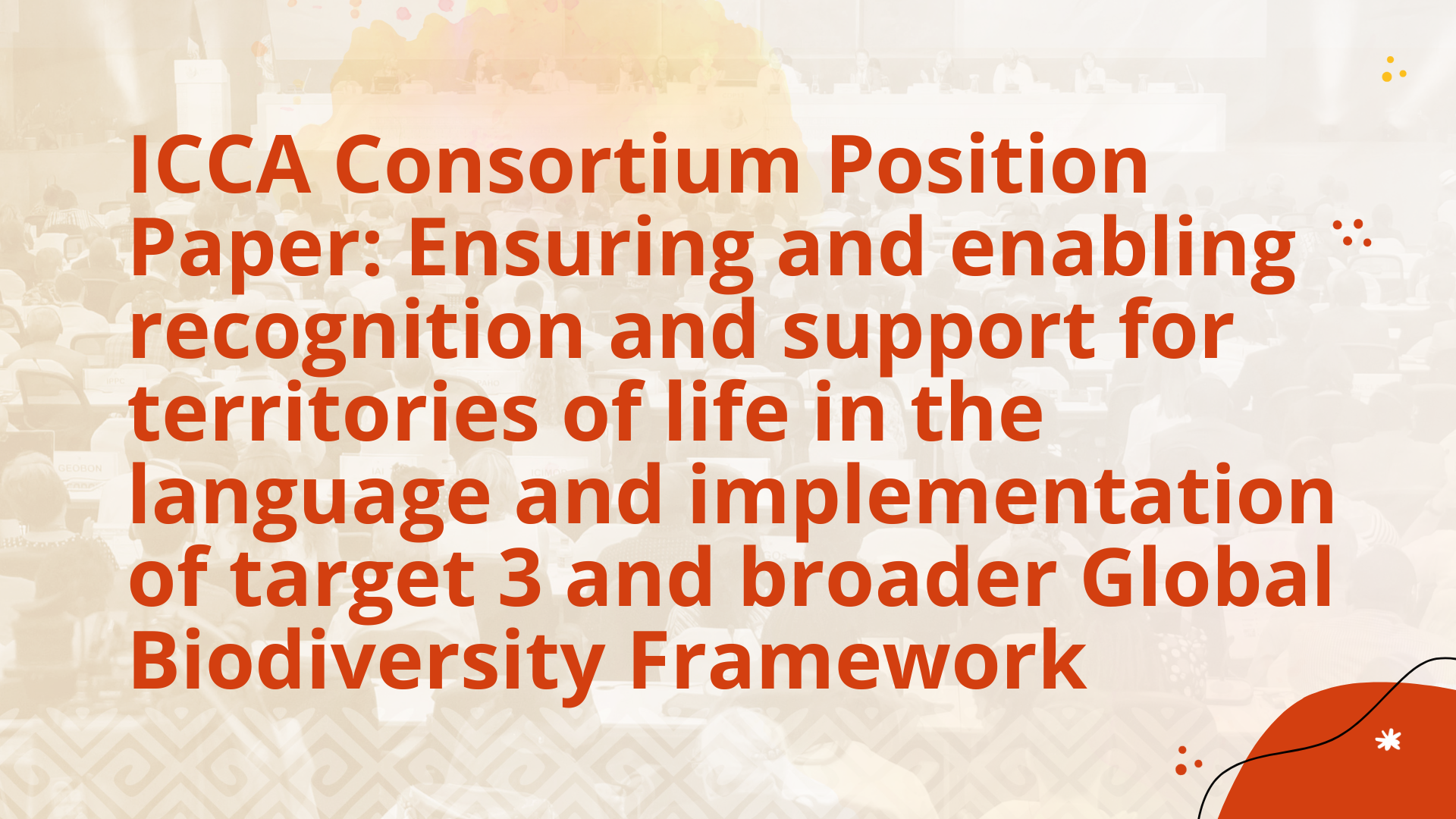ICCA Consortium Position Paper: Ensuring and enabling recognition and support for territories of life in the language and implementation of target 3 and broader Global Biodiversity Framework
First published on 12/08/2022, and last updated on 12/10/2022
By ICCA Consortium
Target 3 and related elements of the post-2020 global biodiversity framework (GBF) of the UN Convention on Biological Diversity (CBD) have the potential to advance recognition and support for the collective rights, roles, and responsibilities of custodians of territories of life and/or to exacerbate existing threats and injustices. If adopted, the language and implementation of Target 3 must be both just and truly ambitious and transformative by appropriately recognizing and supporting the rights of custodians of territories of life – Indigenous Peoples and local communities – and their outsized contributions to nurturing and sustaining the world’s biodiversity and nature.[1]
The Target language should:
- Include “territories, lands and areas conserved by Indigenous Peoples and local communities” as a third pathway to recognition beyond Protected Areas (PAs) and other effective area-based conservation measures (OECMs). The local implications of international conservation-focused designations and frameworks – like PAs and OECMs – vary widely by context but generally do not provide sufficient – or sufficiently diverse – forms of recognition and support for Indigenous and community custodians of territories of life. This third pathway provides more flexibility and space for their self-determined priorities and creative approaches to integrated (rather than siloed) forms of recognition and support in domestic frameworks.
- Retain existing references to “equitably governed” and “respecting the rights of indigenous peoples and local communities” and include reference to the requirement of free, prior and informed consent (FPIC) before any lands, areas, and territories of Indigenous Peoples and local communities are incorporated into, declared or reported on as protected areas or OECMs or any change in the status of rights and/or land is considered.[2]
- Be complemented by other Targets and Goals that explicitly call for a human rights-based approach.
- Be supported with the headline and/or component indicators on governance, equity, FPIC, participation, access to justice, and environmental defenders (either for Target 3 or via explicit links between Targets).
Regardless of the final language, Target 3 implementation must ensure:
- Laws, processes, and practices for recognition and support of territories and areas of Indigenous Peoples or local communities are:
- Determined by and with their full and effective participation; respect their rights; and uphold their vision and values.
- Include appropriate, substantive support, including increased political, legal, technical, and financial support for custodians to continue to nurture their relationships with their territories, self-organize and strengthen their governance systems and collective rights.
- Include recognition of Indigenous Peoples’ and local communities’ diverse governance systems, knowledge systems, and stewardship approaches, in all their forms and contexts, including in marine and coastal areas and the territories of mobile peoples.
- A human rights-based approach (HRBA) to implementation of area-based conservation overall, including ensuring that equity, equality, and effectiveness of existing protected areas and OECMs are improved and sustained, especially in areas where PAs, and with recognition and restitution of past and present injustices and prevention of future harms. Any identification, establishment, expansion, change in status, or reporting of PAs and OECMs will respect the rights, including to provide or withhold FPIC, of Indigenous Peoples and local communities who might be affected.
- Coordination and alignment with Targets 1, 2, and 3, including by applying the recommendations above in the implementation of restoration, land and water use governance, spatial planning, and related land and resource management, and with Targets 19 – 22 and related guidance.
- Robust and inclusive monitoring and reporting, including on governance, equity, and rights. Specific indicators on governance type, equity, and effectiveness are essential to preventing ineffectively governed and managed areas and/or areas with human rights infractions from being counted toward the target and legitimized.
- Advancement in systemic, transformative change. Relying on the expansion of area-based conservation alone is insufficient to address the complexity and urgency of the crises we all face. Economic, political, and power imbalances underpinning development and mainstream conservation must also be transformed.
Download the PDF version of the paper from here
[1] ICCA Consortium (2021). Territories of Life: 2021 Report. Executive Summary. ICCA Consortium: worldwide. Available at: report.territoriesoflife.org.
[2] Human Rights and Biodiversity Working Group (2022). A Rights-based Path for People and Planet: Proposals for Integrating Human Rights in the Post-2020 Global Biodiversity Framework (OEWG-5 & COP15). HRBWG Briefing #4: Prepared for OEWG5 and COP15.
About ICCA Consortium
The ICCA Consortium is a non-profit membership-based association dedicated to promoting appropriate recognition and support for territories and areas conserved by Indigenous Peoples and local communities (abbreviated as “ICCAs” or, more simply, “territories of life”). This position paper is based on reflections offered by Members (Indigenous Peoples’ and community-based organizations, federations, and movements and their supporting civil society organizations and networks) and Honorary members (individuals with expertise and experience) on proposed Targets, with respect for their diverse views. This paper does not constitute an endorsement of Target 3 but aims to provide guidance should it be adopted.
